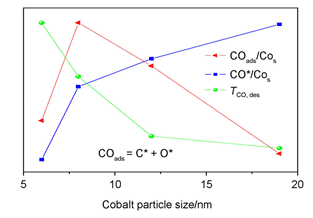| [1] Song, D.; Li, J.; Cai, Q. J. Phys. Chem. C 2007, 111, 18970.
[2] Sun, Y. H.; Chen, J. G.; Wang, J. G.; Jia, L. T.; Hou, B.; Li, D. B.; Zhang, J. J. Chin. Catal. 2010, 31, 919. (孙予罕, 陈建刚, 王俊刚, 贾丽涛, 侯博, 李德宝, 张娟, 催化学报, 2010, 31, 919.)
[3] Botes, F. G.; Niemantswerdriet, J. W.; Van de Loosdrecht, J. Catal. Today 2013, 215, 112.
[4] Wang, Z. J.; Skiles, S.; Yang, F.; Yan, Z.; Goodman, D. W. Catal. Today 2012, 181, 75.
[5] Azzam, K.; Jacobs, G.; Ma, W. Catal. Lett. 2014, 144, 389.
[6] Van Steen, E.; Claeys, M. Chem. Eng. Technol. 2008, 31(5), 655.
[7] Den Breejen, J. P.; Radstake, P. B.; Bezemer, G. L.; Bitter, J. H.; Frøseth, V.; Holmen, A.; De Jong K. P. J. Am. Chem. Soc. 2009, 131, 7197.
[8] Wood, D. M. Phys. Rev. Lett. 1981, 46(11), 749.
[9] Fischer, N.; Van Steen, E.; Claeys, M. J. Catal. 2013, 299, 67.
[10] Prieto, G.; Martínez, A.; Concepción, P.; Moreno-Tost, R. J. Catal. 2009, 266, 129.
[11] Smith, M. L.; Kumar, N.; Spivey, J. J. J. Phys. Chem. C 2012, 116, 7931.
[12] Gao, H. Y. Ph. D. Dissertation, Institute of Coal Chemistry, Chinese Academy of Science, Taiyuan, 2003. (高海燕, 博士论文, 中国科学院山西煤炭化学研究所, 太原, 2003. )
[13] Koizumia, N.; Suzukia, S.; Niiyama, S.; Ibi, Y.; Shindo, T.; Yamada, M. Appl. Catal. A: Gen. 2011, 395, 138.
[14] Borg, Ø.; Dietzel, P. D. C.; Spjelkavik, A. I.; Tveten, E. Z.; Walmsley, J. C.; Diplas, S.; Eri, S.; Holmen, A.; Rytter, E. J. Catal. 2008, 259, 161.
[15] Reuel, R. C.; Bartholomew, C. H. J. Catal. 1984, 85, 63.
[16] Ji, L.; Lin, J.; Zeng, H. C. J. Phys. Chem. B 2000, 104, 1783.
[17] Zhang, J. L.; Ren, J.; Chen, J. G.; Sun, Y. H. Acta Phys. Chim. Sin. 2002, 18(3), 260. (张俊岭, 任杰, 陈建刚, 孙予罕, 物理化学学报, 2002, 18(3), 260. )
[18] Du?, R.; Lisowski, W. Surf. Sci. 1976, 61, 635.
[19] Barbier, A.; Tuel, A.; Arcon, I.; Kodre, A.; Martin, G. A. J. Catal. 2001, 200, 106.
[20] Bartholomew, C. H. Catal. Lett. 1990, 7, 27.
[21] Rodrigues, E. L.; Bueno, J. M. C. Appl. Catal. A: Gen. 2004, 257, 201.
[22] Nowitzki, T.; Borchert, H.; Jurgens, B.; Risse, T.; Zielasek, V.; Baumer, M. ChemPhysChem 2008, 9, 729.
[23] Pauls, C.; Przyrembel, D.; Christmann, K. J. Phys. Chem. B 2004, 108, 14749.
[24] Galhenage, R. P.; Yan, H.; Ahsen, A. S.; Ozturk, O.; Chen, D. A. J. Phys. Chem. C 2014, 118(31), 17773.
[25] Henry, C. R.; Chapon, C.; Goyhenex, C.; Monot, R. Surf. Sci. 1992, 272(1-3), 283.
[26] Schweicher, J. Ph. D. Dissertation, Universite Librede Bruxelles, Bruxelles, 2010.
[27] Swart, I.; De Groot, F. M. F.; Weckhuysen, B. M.; Rayner, D. M.; Meijer, G.; Fielicke, A. J. Am. Chem. Soc. 2008, 130, 2126.
[28] Adachi, M.; Yoshii, K.; Han, Y. Z.; Fujimoto, K. Bull. Chem. Soc. Jpn. 1996, 69, 1509.
[29] Kumar, N.; Jothimurugesan, K.; Stanley, G. G.; Schwartz, V.; Spivey, J. J. J. Phys. Chem. C 2011, 115, 990.
[30] Bian, G.; Nanba, T.; Koizumi, N.; Yamada, M. J. Mol. Catal. A: Chem. 2002, 178, 219.
[31] Ciobîcã, I. M.; Van Santen, R. A.; Van Berge, P. J.; Van de Loosdrecht, J. Surf. Sci. 2008, 602, 17.
[32] Rane, S.; Borg, Ø.; Rytter, E.; Holmen, A. Appl. Catal. A: Gen. 2012, 437-438, 10.
[33] Park, J. Y.; Lee, Y. J.; Karandikar, P. R.; Jun, K. W.; Ha, K. S.; Park, H. G. Appl. Catal., A 2011, 411-412, 15.
[34] Song, D.; Li, J. J. Mol. Catal. A: Chem. 2006, 247, 206. |
